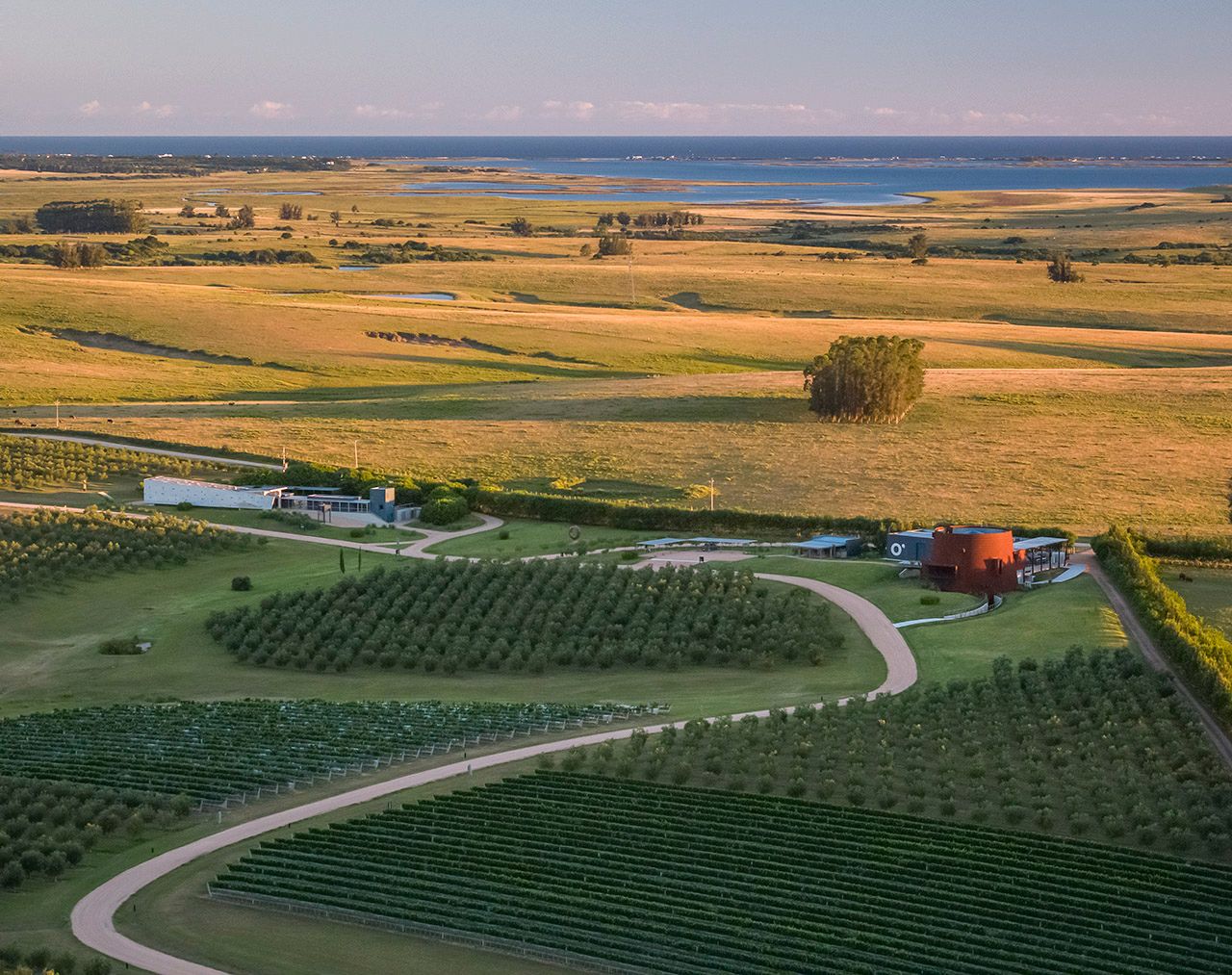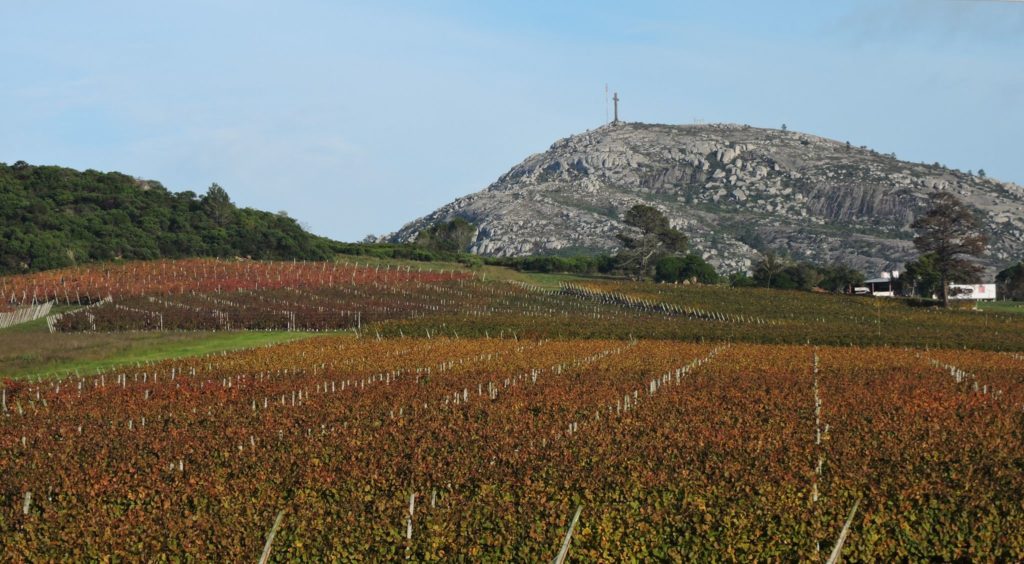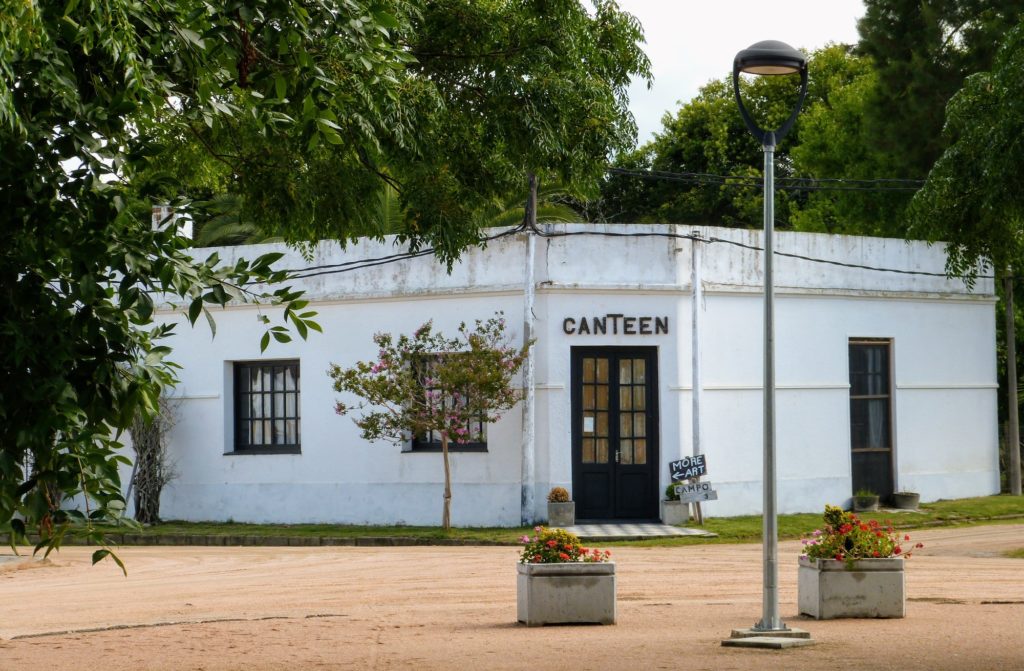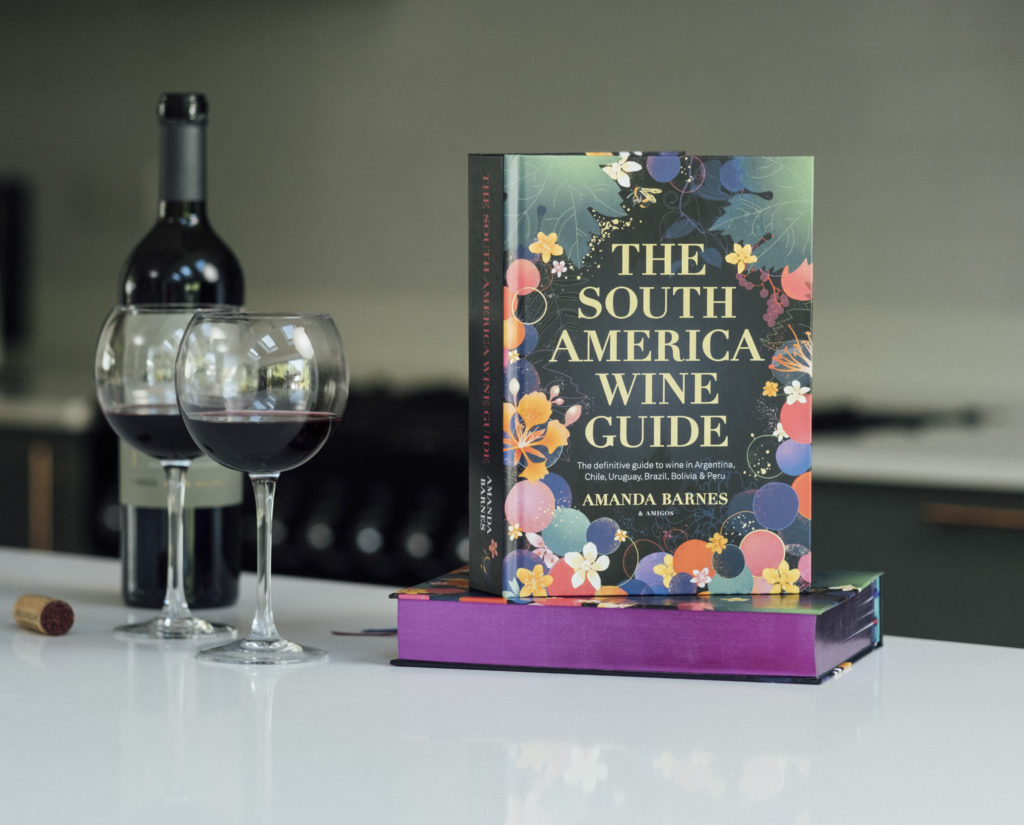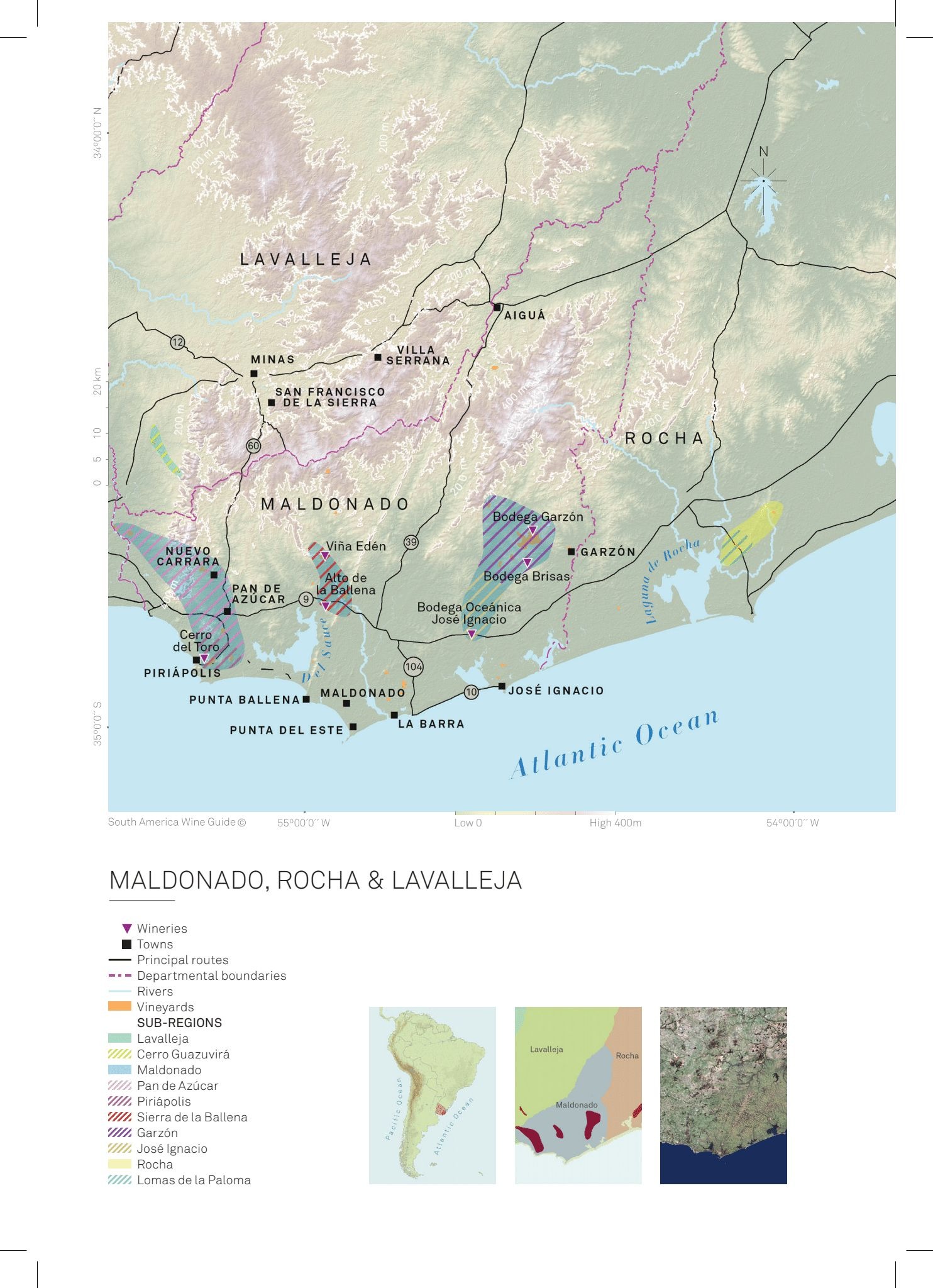The Maldonado wine region of Uruguay is one of the continent’s most exciting — offering a distinctive style of refreshing coastal wines. Get to grips with the unique terroir and delicious wines of Maldonado in our quintessential guide.
Guide to Maldonado Wine Region
Notable Producers in Maldonado
Quick Guide to Maldonado
Best Wines to try from Maldonado
Map of Maldonado
Guide to Maldonado wine region & its refreshing coastal wines
Maldonado is a region of great contrasts. On the one hand, there’s the ostentatious seaside resort of Punta del Este, home to some of the most luxurious hotels and wealthiest casinos in Latin America and on the other, there is sweeping farmland with modest homes and tiny villages, which seem to have remained grounded in the last century.
While I’m not a fan of the superficial veneer that makes Punta del Este stand out in sharp juxtaposition to the otherwise authentic and unassuming charm that Uruguay exudes elsewhere, millions of people are. In fact the population of this elite playground known as the ‘St Tropez of Latin America’ swells fivefold every summer.
A major silver lining to having ‘St Tropez’ on your doorstep is that the huge tourism industry is a great bedfellow for Uruguay’s wine industry, and Punta del Este is the main market for Uruguay’s wineries. The growing wine route in Maldonado has also developed thanks to this steady stream of affluent tourists cruising in. Fortunately for them, Maldonado is home to some of Uruguay’s most exciting wines today, which have completely revitalised the wines and image of the country as a whole.
How it started…
Although Maldonado is often referred to as the new frontier of Uruguayan wine, the coastal region has actually been planted with vines since the 1890s, when an ambitious businessman, Francisco Piria, bought 2,700 hectares of virgin land there. His goal was to create a resort unlike anything seen before — the land of Piriápolis or, as he liked to call it, El Balneario del Porvenir, meaning ‘the resort of the future’. It was just as grandiose and outlandish as it sounds and within a few years Piria had built castles, palatial hotels and beachfront promenades. Piriápolis was very much the predecessor of Punta del Este today. Part of Piria’s grand plan included wine production, and he soon planted 72 hectares of vines and built a winery just in front of his castle.
Piria was, however, a rather lonely pioneer and, although he was a visionary in his time, the wine region was seen as hard work with little return and, on his retirement, the winery was abandoned. The rocky soils and steep, bumpy hillsides were regarded as terrible farmland and nowhere near as valuable as the flat, fertile and arable land of neighbouring Canelones or other areas further inland. This was a false start to Maldonado’s wine story.
Maldonado today…
That story didn’t get kickstarted again until a century later, in 2001, when a young couple decided to quit their finance jobs in the city and start a new venture on the virgin terrain of a popular lookout spot for whale watching, just behind Punta del Este. Paula and Alvaro Pivel bought 20 hectares of unplanted land on the Sierra de la Ballena and planted Tannat, Syrah and Cabernet Franc vines on the granite hillsides. These first-time vignerons rather serendipitously proved that these poor farming soils were actually excellent for wine — albeit much harder to work. The free-draining soil, hilly topography and the strong, cool coastal winds that blow through it mean that Maldonado produces healthier grapes with more fruit definition and fresher acidity than most other Uruguayan wine regions.
Within the last 20 years, the region of Maldonado has boomed and it now has almost 400 hectares of vines and more than two dozen producers — numbers which I have no doubt will continue to grow.
About the Wineries in Maldonado
Most are small wineries, owned by families who have moved here for a change of pace and to start a wine business, often with a tourism focus — as is the case withBodega Oceánica (pictured in the main image), Viña Edén andCerro del Toro, for example. Nonetheless, they spare no expense in planting this challenging terrain, which requires heavy investment from the outset. A number of established Uruguayan wineries have also invested in the region, notably Bouzaand Familia Deicas, who came here in search of the exciting new dimension that these poor, granitic and gneiss-based soils and the cooler, breezier Atlantic climate can bring to Uruguayan wine.
And then there’s also the modern-day Piria of Maldonado’s wine industry: the Argentine businessman and billionaire Alejandro Bulgheroni. He catapulted this region into the limelight in 2008 by planting 240 hectares of vines on his 1,500-hectare estate and splurging extravagant amounts of money on a state-of-the-art winery in Garzón.
Not only is his US$85 million investment inBodega Garzón the biggest wine investment ever seen in Uruguay, one which no doubt would have inspired awe in Piria himself, but it is also among the biggest in modern times in the whole of Latin America and the New World. The fact that this all happened in Maldonado says a lot about the confidence his team of expert wine consultants have in this up-and-coming wine region, one which no-one had even heard of a decade or so ago.
Although Bodega Garzón has a grandiose private-kingdom-feel like Piriápolis did in its day, Bulgheroni hasn’t built castles and grand hotels, as Piria did. Instead he has rather left nature to its course, keeping a native 200-hectare subtropical forest intact and carefully landscaping the world’s first Silver LEED winery and vineyard around the native flora and fauna, which include rheas, wild boars, foxes and dozens of bird species. Of course, there are plenty of luxurious touches in the lustrous winery, but the property tastefully respects the true luxury of Maldonado — the unspoilt nature of its countryside.
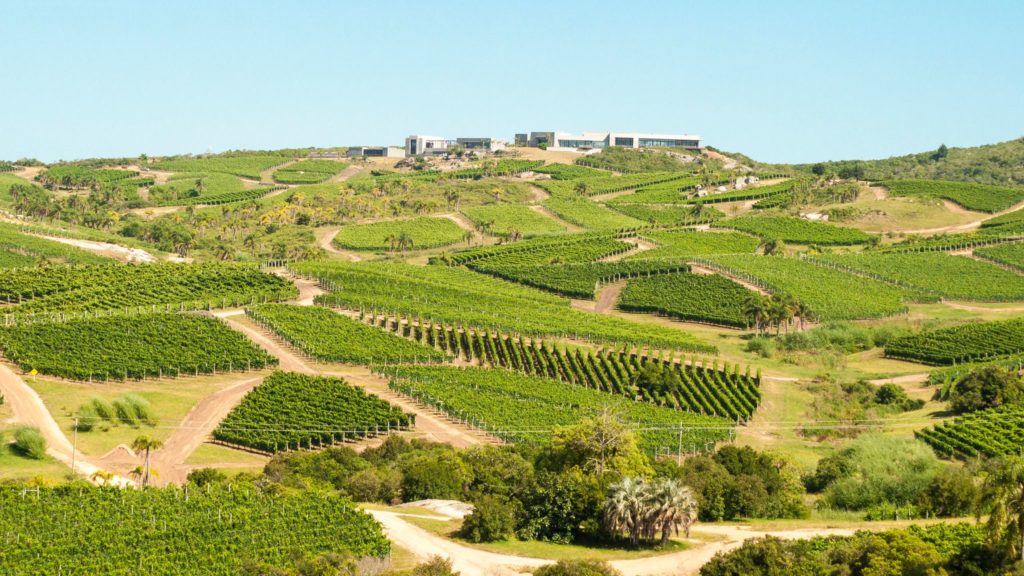
And it’s this unspoilt side of Maldonado, the rural, blissfully remote side, that most appeals to many of us. It was the remote fishing village of José Ignacio that first attracted Argentina’s most famous chef Francis Mallmann to open a restaurant there in 1977, but when that was transformed into a glamorous coastal resort, he moved to the bucolic hills and quaint village of Garzón further inland.
Maldonado certainly does have that magical quality where it seems as though everything you touch turns to gold. But, for now, there still remains a calmer, yesteryear side to the region that has an allure all of its own. Driving along the bumpy backroads and country lanes in my clapped-out hire car, having to stop in the middle of the road for 20 minutes while a herd of cows crossed, and sitting in the empty, leafy plazas of peaceful villages are among the moments I have savoured most in Uruguayan wine country.
Notable Producers in Maldonado
ALTO DE LA BALLENA
The modern-day pioneer of Maldonado and, although boutique in nature, one of the leading wineries in the region
BODEGA BOUZA
One of the leading wine producers in Uruguay with an exciting range of wines coming from vineyards in Montevideo, Canelones, and Maldonado
BODEGA GARZÓN
A 240-hectare wine estate on granitic hillsides in coastal Maldonado with a state-of-the-art winery. Precision viticulture and winemaking techniques mean the team have isolated over 1,000 different plot that are all vinified separately
FAMILIA DEICAS
The Deicas family took over the historic 18th century estate and winery of Establecimiento Juanicó in 1979, a brand which continues to be a market leader in Uruguay today, and in 2000 launched their own luxury brand, Familia Deicas
BODEGA OCEÁNICA JOSÉ IGNACIO
This thrilling new winery, vineyard, and olive grove are the passion project of Marcelo Conserva and Natalia Welker, with flying winemaker Hans Vanding Diers as consultant
VIÑA EDÉN
This state-of-the-art winery and sustainable vineyard in Maldonado are the brainchild of Brazilians Mauricio and Rosane, who invested in the 250-hectare estate just outside of Punta del Este
CERRO DEL TORO
On the slopes of Cerro del Toro, just a couple clicks from Piriápolis beach, is a new wine project that has had already promising early results, set up by the Japanese Kambara family
BODEGA BRISAS
One of Uruguay’s newest and largest wineries today, completed in 2019 with a state-of-the-art winemaking facility. Brisas is part of the Maldonado wine estate of Alejandro Bulgheroni and his second winery in Uruguay
Quick Guide to Maldonado
Hectares planted
411 hectares
Sub-regions in Maldonado
Garzón, Pan de Azúcar, José Ignacio, Sierra de la Ballena, Piriápolis
Soil type
Generally poor, well-draining soils with ancient, decomposed granite, sand, gneiss, and quartz components
Grape varieties & wines
Many varieties thrive here – from fresh whites and delicates rosés to characterful bubbles and spicy reds
Terroir Selection: Best wines to try from Maldonado
Maldonado is also home to some of my favourite wines from Uruguay, which reflect the region’s proximity to the ocean, being racier, often more saline and bracingly mineral in style. This transparent expression of place is also aided by the fact that the handful of new producers here really represent the modern school of Uruguayan winemaking with lo-fi winemaking techniques and fruit-driven wine expression. This is a fantastic region for unoaked (or lightly oaked) Tannat that displays all the verve and tension you get when you combine granitic soils and a slightly cooler climate with this gutsy grape variety. But Maldonado isn’t only about Tannat. Some of my other favourite wines are the perfumed and grippy Pinot Noir, nervy Riesling and aromatic, tangy Albariño.
Sure, there’s a lot of glitz and glamour in Maldonado. But there’s also Old World charm and a peaceful pace of life that hasn’t changed much in the hundred years since Piria came to build his fantasy land. As a golden land of plenty, there’s a fantasy world here for everyone in Maldonado — and a wealth of great wine to accompany you on your adventure into Uruguay’s most seductive coastal region.
GARZÓN, Balasto
Garzón. $$$$. Drinking window <20 years
The focus here is on the energy, fruit and tension of this Tannat-Cabernet Franc blend (with a dash of Marselan and Merlot) from the top plots of Garzón’s vineyard in the granitic hills. A wine filled with precision and verve, with bright red fruit, floral and mineral aromas.
FAMILIA DEICAS, Extreme Vineyards Cerro Guazuvirá
Lavalleja. $$. Drinking window <20 years
This is a thrilling wine from the volcanic hillsides of Cerro Guazuvirá. A blend of Merlot, Tannat, Petit Verdot and Viognier, with a quixotic combination of red fruit, graphite and floral notes, it is bracing on the palate with a focused and lingering finish. A really exciting wine showing the great potential of Lavalleja.
BOUZA, Riesling Viñedo Pan de Azúcar
Pan de Azúcar. $$. Drinking window <10 years
The Bouza family’s new vineyards in Maldonado are incredibly exciting and this Riesling already shows the great potential for racy white wines here. White blossom, lime zest and waxy notes with a saline minerality, this is one of the best Rieslings in Latin America.
ALTO DE LA BALLENA, Cetus Syrah
Sierra de la Ballena. $$. Drinking window <15 years
This is my favourite Syrah in Uruguay and it reminds me of a juicy, Rhône-style wine, filled with exotic spice notes, wildflowers, black pepper and juicy black fruit aromas. This is a voluptuous wine that ages really well and stands up nicely to rich lamb dishes. Their Cetus Merlot-Cabernet Franc is another delicious blend in this range.
CERRO DEL TORO, Albariño
Piriápolis (Cerro del Toro). $$. Drinking window <5 years
This debut vintage of Albariño shows the potential of this extreme site on the slopes of Cerro del Toro in Piriápolis, just two kilometres from the sea. Intense and precise with aromas of citrus zest, fennel and sea salt, it’s a bracing and mouth-watering coastal wine.
BODEGA OCEÁNICA JOSÉ IGNACIO, Pinot Noir Rosé
José Ignacio. $$. Drinking window <3 years
With Hans Vinding Diers as consultant winemaker, this new boutique winery has got off to a flying start and all of their wines reflect the refreshing coastal climate. My favourite summer pour is their Pinot Noir Rosé — delicate, filled with floral and red fruit aromas, and ideal for drinking on the beach. A testimony to the great potential for coastal rosé in Uruguay.
VIÑA EDÉN, Brut Nature NV
Maldonado. $$. Drinking window <10 years
Viña Edén makes smart red wines too, but their bubbles have helped put Maldonado on the map as a promising sparkling wine region for Uruguay. This Brut Nature shows off the pure, zesty and mineral expression of Chardonnay and Pinot Noir from the region, with a nutty complexity from almost two years on the lees and a mouth-watering, bone-dry finish.
GARZÓN, Single Vineyard Petit Verdot
Garzón. $$. Drinking window <15 years
Every variety of Garzón’s Single Vineyard range is a triumph, showing great typicity and the vibrancy of their Maldonado terroir, but Petit Verdot is a hard act to pull off in this coastal climate, and this wine does it with aplomb. Although planted on the warmer north-facing slopes, it is a distinctively cool-climate Petit Verdot with notes of violets, lavender, crème de cassis and wild herbs. Seductive on the nose, thrillingly fresh and peppery on the finish.
BODEGA BRISAS, Altos de José Ignacio Reserva Tannat
Maldonado. $. Drinking window <10 years
Embracing the modern school of Tannat, this vibrant wine not only extols the virtues of youthful Tannat but also shows. what great vaue Maldonado can offer. It is a savory wine with notes of graphite and fresh black forest fruit with a spicy finish. An absolute steal.
Want to know more about Maldonado and the wine regions of Uruguay?
ORDER YOUR COPY of The South America Wine Guide now!
E-book AVAILABLE ONLINE too.
Map of Maldonado, Rocha & Lavalleja wine regions
You can download all the wine region maps for South America for free on this link. Please feel free to share and use the wine region maps while crediting @SouthAmericaWineGuide.
Read more about Uruguay wines
Beyond Tannat: Three up-and-coming varieties in Uruguay
